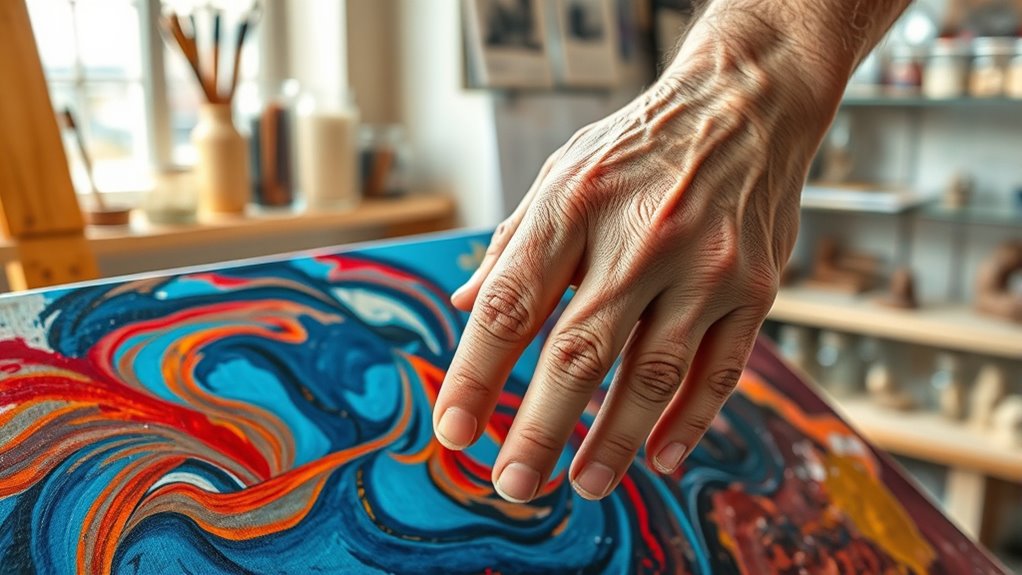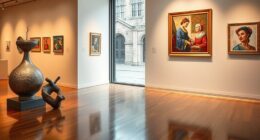Engaging in art as you age boosts your mental agility, strengthens memory, and stimulates neural connections, helping your brain stay sharp. It also provides a meaningful way to express emotions, increase self-awareness, and maintain a sense of identity. Participating in creative activities can improve fine motor skills, promote social connections, and reduce feelings of loneliness. If you want to explore how art keeps your mind and spirit vibrant in later years, keep exploring these inspiring benefits.
Key Takeaways
- Engaging in art boosts cognitive health and neural connectivity, supporting mental agility in later years.
- Artistic activities foster emotional expression, self-awareness, and a sustained sense of identity during aging.
- Creating art enhances fine motor skills, coordination, and physical independence in older adults.
- Participating in art groups encourages social interaction, reducing loneliness and promoting emotional well-being.
- Pursuing creative endeavors offers ongoing personal growth, joy, and purpose beyond youth.

As we age, engaging with art offers more than just aesthetic pleasure; it can enhance mental agility, foster creativity, and provide a meaningful way to express life experiences. When you immerse yourself in creative activities, you tap into a powerful form of creative expression that keeps your mind active and flexible. This isn’t just about making pretty pictures or crafting; it’s about using art as a tool to stimulate your brain’s neural pathways, which can lead to significant cognitive benefits. Regularly engaging in artistic pursuits helps improve memory, problem-solving skills, and concentration. It encourages your brain to form new connections, which is especially important as you get older and natural cognitive decline might set in.
You don’t need to be a professional artist to enjoy these benefits. Whether you’re painting, drawing, sculpting, or even experimenting with digital art, the act of creating allows you to process emotions and memories, giving you a sense of accomplishment and purpose. This process often leads to increased self-awareness, helping you better understand your feelings and experiences. As you express yourself through art, you also foster a sense of identity that remains essential and vibrant, reinforcing your sense of self amid life’s changes. The physical act of creating—holding a brush, shaping clay, or sketching on paper—also enhances fine motor skills, keeping your hands and fingers nimble. Additionally, engaging with art can serve as a form of cognitive stimulation that supports brain health and resilience in later years.
Furthermore, engaging with art in later life can open doors to social connection. Participating in art classes or group projects creates opportunities to meet others, share ideas, and find community. These interactions are indispensable for mental health, reducing feelings of isolation and loneliness. Art provides a common language, enabling you to connect with people regardless of age or background, which enriches your social life and emotional well-being. Over time, you may find that your creative expression not only boosts your brain health but also offers a sense of joy and fulfillment, reminding you that aging doesn’t mean slowing down—it’s an opportunity to explore new avenues of self-discovery.
In essence, the act of creating art in later years is a multi-layered process that benefits both your mind and spirit. It’s a way to stay mentally sharp, express your unique life story, and build connections with others. By embracing art, you nurture your cognitive health and reinforce your capacity for creativity, proving that it’s never too late to find new ways to grow and thrive.
Frequently Asked Questions
How Does Art Impact Mental Health in Senior Adults?
You’ll find that engaging with art can markedly boost your mental health by enabling emotional expression and reducing stress. As you create or appreciate art, your self-esteem enhances because you feel accomplished and valued. This process also offers a healthy outlet for feelings, helping you manage anxiety or depression. Overall, art becomes a powerful tool for emotional well-being, fostering resilience and a positive outlook during your later years.
Are There Specific Art Forms Best Suited for Older Beginners?
If you’re a beginner, accessible art forms like drawing, watercolor painting, or simple clay modeling are great choices. These beginner-friendly arts require minimal equipment and skills, making them perfect for older adults just starting out. You’ll enjoy expressing yourself without feeling overwhelmed. Focus on activities that are easy to learn and promote relaxation, helping boost your confidence and mental well-being in a fun, accessible way.
Can Art Therapy Help With Age-Related Cognitive Decline?
Art therapy can greatly help with age-related cognitive decline, opening neuroplasticity benefits you might not realize. Through creative expression, you stimulate your brain, keeping it agile and adaptable like never before. This process encourages new neural connections, improving memory, mood, and mental clarity. So, engaging in art therapy isn’t just fun; it’s a powerful way to boost cognitive health, making your mind sharper and more resilient with each stroke.
What Barriers Do Seniors Face When Engaging in Art Activities?
You may face barriers like limited technology access, which makes it harder to find or use online art resources. Physical limitations, such as decreased dexterity or vision issues, can also hinder your participation in art activities. These obstacles can discourage you from engaging creatively. However, with adaptive tools and support, you can overcome these barriers and enjoy the enriching benefits of art in your later years.
How Can Communities Better Support Older Artists?
You can better support older artists by expanding community art programs tailored for seniors, making art accessible and affordable. Encourage senior artist mentorship opportunities that foster skill-sharing and boost confidence. Offer flexible class schedules and transportation assistance to reduce barriers. Recognize and celebrate their work publicly, creating a vibrant environment where older artists feel valued and inspired. Your support helps nurture their creativity and enriches the entire community.
Conclusion
As you embrace art and aging, you open unexpected energy and expression. Creativity continues to cast a comforting coat, cultivating confidence and connection. By blending boldness with beauty, you build a bridge between past passions and present possibilities. Remember, your artistic adventure isn’t over; it’s an ongoing opportunity to inspire, ignite, and influence. So, seize each stroke, savor each second, and let your lifelong love of art illuminate your later life with limitless light.










